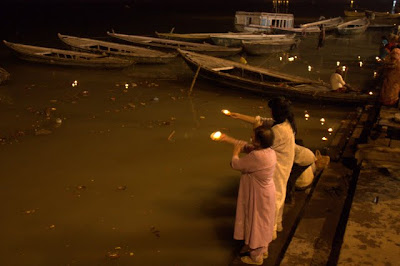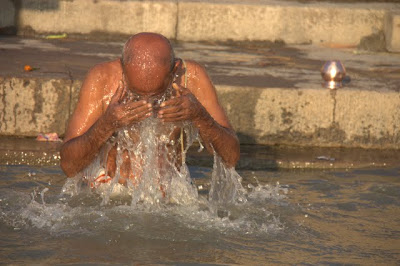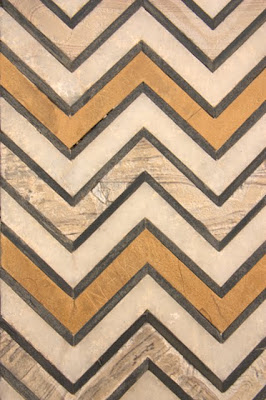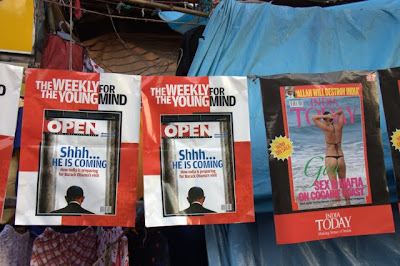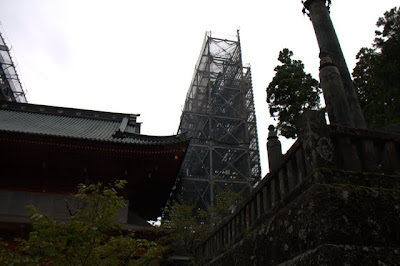Holiness

Assi Ghat, shortly before dawn. This might be my favorite photograph of the whole year. The colors really did look like that.
Out of all of the holy places in a very holy country, Varanasi may well be the holiest. Varanasi lies on the Ganges River southeast of Delhi. The Ganges River is considered to be holy by the Hindu faith, so devout pilgrims make their way to Varanasi to immerse themselves in the waters. They bathe, dip, swim, pray, splash, launder, and wash in the river. Some even die there. Hindus believe that dying in Varanasi liberates the soul from the endless birth/death cycles they’d otherwise be subjected to if they died elsewhere. Cremations occur at the burning ghats on the side of the river, and bodies are carried down to the Ganges to their final resting place. The thing is, thanks to the mix of garbage, sludge, sewage, and creamated bodies that enter its waters, the Ganges is actually septic. Some uneducated people don’t know. Other people know and don’t care.
As you could imagine, Varanasi was a whole new level of intensity for us. To be surrounded by so much faith and so many private moments that are lived out loud in public was fascinating and overwhelming. The septic waters may not be scientifically capable of creating new life, and people may be dying all around, but Varanasi is one of the most alive places I’ve ever been.

Even though Varanasi is a holy place, above all else it is an actual city. This school bus rickshaw made us smile.

We typically took the auto-rickshaws and passed up the ones that are pulled by bicycle because it just seemed so uncomfortable to force another human to pull our weight around by his own.. This guy looked so crestfallen when we first refused the ride that we reconsidered and decided we should give him an opportunity to earn a living too. Although the slow ride made us miss the beginning of the night ceremony at the Dasaswamedh Ghat, riding on the cycle rickshaw gave us a totally different perspective than the noisy, exhaust spewing auto-rickshaws.

Varanasi is one of those places where you struggle over whether you should really be there, paying to observe real life, but in the end you participate like everyone else and try to make yourself feel better by saying, well at least I'm just observing, not intruding. We paid this man to row a boat down the Ganges at dawn like so many other tourists. The rowing is hard work and he was quick to let us know it, playing on our heartstrings with tales of his children in broken English to ensure a tip. Travel. It's complicated.

Sunrise on the Ganges. The light created is one of the most incredible things I've seen in my whole life. It makes the brown waters luminescent.

Everyone is doing their own thing in close proximity as if the others aren't there. Bathing, laundry, praying, sitting.
Taking Pictures of People Taking Pictures
Probably one of the best parts of visiting the Taj Mahal, maybe even better than viewing the building itself, was watching the many sideshows circling round the Taj. Every day, visitors from around the world and India itself stream in and out of the Taj Mahal, all posing for a multitude of pictures with themselves and their favorite building.
We spent a good hour or two people watching and taking pictures of people taking pictures. Western tourists seemed to prefer the solitary poses, while the massive group shots with you and 30 of your closest friends were the fortay of the Indian tourists.

We watched two giggly Japanese girls pay a local to follow them around and snap photo after photo of them flashing peace signs, while not far away a group of at least thirty Indian women streamed by with a rainbow collection of saris to contrast with the Taj’s creaminess. People even wanted to take photos of ME.
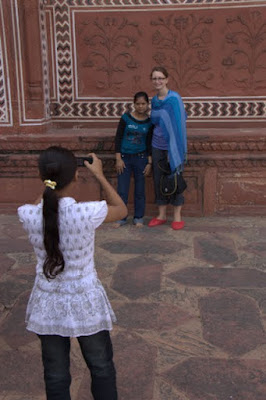
Hope they cropped the dorky shoe covers out of their photo. What do people do with these pictures? Am I on a blog somewhere?
I’m not sure exactly how many of the tourists pretend to pinch the Taj Mahal between their fingers, but it seemed like it was the rare person who could stifle the impulse.
We may have refrained from engaging in that particular optical illusion, but I did succumb to the need to sit in a Princess Diana pose.
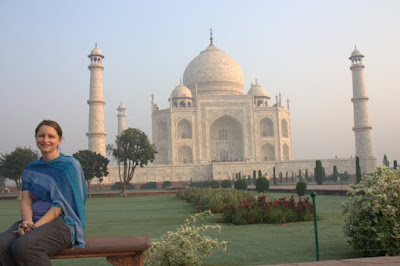
Hands down, our favorite sideshow was watching the more athletic and persistent tourists who entertained us (and a gawking crowd of Indians) by repeatedly trying out their best yoga pose or going for the money jump shot. Hope they captured it, because we did.
The Taj Mahal of Agra
I’m not sure why we bothered to visit the Taj Mahal, really. Considering we used to live in a building so similar. Or at least that’s what our old landlord told us. Before we were married, we rented a 2-story duplex in Etna. On the phone when I was setting up an appointment to view the duplex, the landlord told me, You’ll definitely recognize the building. It is the big one on left side of the street. It is so grand that some people call it the Taj Mahal of Etna.
I definitely see the resemblance. Don’t you?
The Taj Mahal of Agra, on the other hand, is really a spectacular building. It gleams, especially in the early morning light in the couple of hours after sunrise. I’m a sucker for symmetry. It’s what I fell in love with on our first house (not the rental) and it’s what I fell in love with on the Taj. I knew the Taj Mahal would be beautiful from afar; I didn’t realize that it would also be so beautiful up close. Its elegance astounded me.
The true test of how amazing the Taj Mahal was its ability to lull us out of our cranky moods. The night before we visited, we went to bed at a decent hour because we planned to get up at sunrise. India had other plans for us. There was some sort of festival going on – always a festival – that involved tinny, haunting music blasting out of a loudspeaker. A loudspeaker that was directly outside our room. A loudspeaker that, true to its name, was so loud that we could still hear it even when we played music through our noise-isolating headphones. The only way to drown it out was to play the most raucous rock’n’roll we had on top volume. Periodically the festival music would die down. Once we realized, we’d turn off our Ipods and settle in for some sleep, finally. Then, chanting would begin, followed by music even louder than before. This special brand of torture didn’t end until 3:30 in the morning – two hours before sunrise. It is a good thing the Taj Mahal of Agra didn’t look a thing like the Taj Mahal of Etna.
Delhi and the Obamas
I think it is fairly obvious from our posts about India so far that Delhi, India’s capital, was our least favorite spot in India. Everything I wrote about India happens all at once in Delhi, all day long, with no respite. Unfortunately for us, it also was our first stop in India. In most of the places we visited in India, the highlights outweighed the lowlights, but we didn’t find much to love about Delhi. We spent most of our four days in Delhi on logistics, quickly realizing how long it takes to get anything done in this country. I swear we spent most of our time riding the metro back and forth from our hotel in East Patal Nagar. We thought it might be a good idea to stay in a non-touristy area in New Delhi, but our plan backfired. The neighborhood where we stayed wasn’t any less hectic, we had trouble finding places to eat, and we constantly had to ride the crowded metro to go anywhere.
We did find a little time to take in Delhi’s craziness and some of its sights, including Humayun’s Tomb, which would be visited by President and First Lady Obama several weeks after us during their trip to India. The Obamas’ every move was broadcast on Indian news stations, although we suspect it was probably nothing more than a blurb at home. Anytime we replied the United States in response to inquiries about where we were from, we’d receive a hearty response of yes, Obama! Coming to India! But much like at home, at least according to an Indian news magazine I picked up after the Obamas left, Michelle was a bigger hit than her husband during their visit. She impressed the Indians by dancing freely with children during a school visit, but also like at home, she still can’t catch a break for her outfits. The Indians thought her outfit choices were drab and would have liked to have seen her in brightly colored saris. Hey, at least she covered her pipes.
New Country Day
One of my favorite things about traveling non-stop for an entire year is what we call New Country Day. Even though New Country Days usually involve long uncomfortable bus rides, or overnight trains, or multi-leg flights with time changes, and figuring out logistics like where to stay, how to get around, and where to eat, New Country Days have a level of excitement and anticipation unmatched by any other day. On New Country Day, the whole country lies before you, waiting for exploration.
As much as I enjoy seeing the subtle ways that the cultures of neighboring countries blend into each other when we travel overland, one unique aspect of flying is how it drops you right into a completely different environment. By this point in our trip, we’ve had some pretty big transitions: France to Morocco, Spain to the Czech Republic, Poland to Ireland, Ireland to South Africa, South Africa to Jordan, Jordan to South Korea. And, of course, Japan to India.
You probably couldn’t find two countries who are fundamentally different: Japanese society is predicated on order, and Indian society is predicated on anything but. One of the reasons I think I found India to be so shocking was because we just had spent a month in Japan. Japan was pleasant and enjoyable, but by the end, we were a little bored and itching to move on. And move on we did.
(A note about Delhi’s metro – the picture above doesn’t really reflect what it was like most of the time. I would have loved to have taken a picture in the height of the crowds, but it is a little hard to use your camera when you are being jostled and pushed in all directions. At times, the metro cars are stuffed to the gills, meaning that people have no room to stand and don’t fall down only because they are being held up by the compression of the crowd. When the metro rolls up to the platform, people impatiently waiting for the metro push their way on as people already on the metro push their way off. In the more crowded, popular stations, an attendant tries to keep people in line. Try being the operative word. As you can imagine, as unpleasant as it is for men to ride Delhi’s metro, it can be distressing for women. The first couple of times we rode the metro, I rode with Sean in the general cars, doing my best to shield myself from stares from the men around me with a scarf and sunglasses. Once we started encountering metros that were overflowing, I separated from Sean to ride in the women’s only car. Delhi instituted the women’s only car so women can avoid the physical contact, leering, and groping that can be part and parcel of riding in the general car. Yet I’m not sure that riding in the women’s car was much better. I may not have to stand pressed between sweaty men, but the leering was worse. Inevitably, the overstuffed nature of the men’s car compared to the extra room in the women’s car meant that men overflowed into the front of the women’s car. It often seemed like the most pervy men took advantage of overcrowding to get an unblocked access of a car full of women. Some defiantly strode right into the middle of the women’s car. It is not surprising, I suppose, that things are so bad that a women’s only car is required, that some men don’t follow the rules. At the most crowded stations, enforcers boarded the women’s only car and shouted at the men until they scurried away. Interestingly, all of the enforcers that I saw – the few that there were – were petite women. I didn’t realize until I wrote this post that the women’s only car had only been instituted in the month before our arrival, so perhaps conditions have improved.)
(As a further sidenote, Japan also has women’s only cars, but the restrictions only applied during rush hour. We never saw a need for a separate women’s car firsthand during our subway travels in Japan.)

